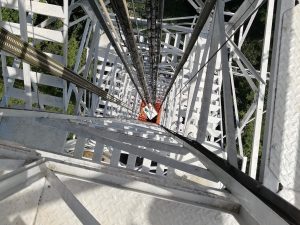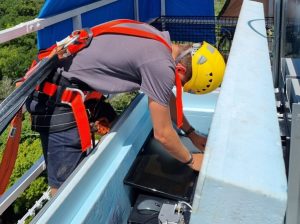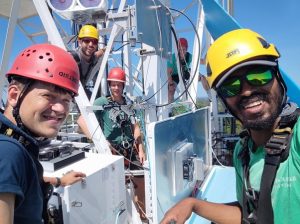Welcome to the jungle!
Written by: David Bonell (Thenician IMAU, Utrecht University)
A troop of howling monkeys wakes the ATTO camp up just in time for breakfast at 5:45 AM. Ham, cheese, eggs, and a colorful line-up of tropical fruits invitingly await on the kitchen’s tables. This week, MAQ and IMAU are working side by side to complete the installation of all equipment. The skies are clear and the sun is rising. It’s showtime!
A balcony at a height of 56m will host a big part of the CloudRoots set-up: an eddy covariance system, a long-path scintillometer over the rainforest’s canopy, and two stable isotope instruments measuring water and CO2. This set of instruments allows us to study the exchange of matter and energy between the canopy and the lower layers of the atmosphere.
Climbing the tall tower, the rainforest’s immensity quickly becomes obvious. The sunshine hits our faces as we elevate beyond the Amazon’s roof. When we step on the two-meter-wide balcony, which was built specially for us, we begin to realize where we truly are. The treetops extend as far as our eyes can reach, and they are accompanied by a perennial concert of sounds we have never heard before. Breathtaking.

Half-way there… Hoisting the field enclosures was an impressive endeavor.
However, there is little time for enjoyment. Measuring tapes are rolling on the balcony’s floor. A few agreements and pictures later, the plan is in place. It’s time to lift the equipment, previously tested at the tower’s base. Valmir, our local hero, and some of his colleagues help us carry a few instruments up the stairs. The rest will be hoisted to the balcony’s level through the tower’s structure. We thought the shipping process was complex, and now here we are tying ropes around these massive boxes… We can only hope the lines will hold and our instruments won’t free fall into oblivion. But Valmir looks calm and confident about this operation, and confident we become once we see a pick-up truck arriving with the site engineer, Sipko, and the locals David and James as extra manpower to help us meet the challenge.
Surprisingly, we manage to lift a few hundred kilos of instrumentation and pumps within a couple of hours. Now it’s time to set everything up before the campaign starts the following week. From sunrise to sunset, day after day, the IMAU team installs and troubleshoots the two systems that will measure stable isotopes during the campaign. To be fair, it’s mostly troubleshooting the quasi-infinite array of issues that appear during installation.

Robbert Moonen in the ‘zombie position’ while troubleshooting one of the laser spectrometers.
To begin with, we manage to overload the tower’s electrical system. Karl, the engineer in charge, is fortunately at the camp this week. He helps us extend and connect two additional power chords that will allow us to distribute our power consumption evenly. Fixed. Next… we have leaks. We have a limited supply of gases to calibrate and operate the instruments, and the first cylinder is running out faster than expected. No time to lose now. We ceremoniously inspect and spray every fitting and connection to see if we can find any bubbles that would indicate gas leaking out… and indeed we do! After some extra tightening, the pressure is stable. Fixed. Luckily, the remaining gas should suffice for the whole campaign.
A few – or not so few – issues later, we seem to be getting there. The time has come to flip the switch and confirm that our instruments still work after travelling across ocean and jungle. We set them in their enclosures, connect cables and valves… and click. Blinking LEDs everywhere, the familiar sounds of turning fans and buzzing pumps bring a smile to our faces. As the screens load up and the instruments begin to measure, we stare at each other in complete awe. This is it; we are measuring isotope fluxes above the Amazon rainforest!

Up and running! The happy faces of the IMAU team with Martin and Sipko, whose help was crucial during installation.
